How to purify water from a well: filters and folk methods
If water is supplied to the house from a well, it requires cleaning. Sand, clay, iron, manganese, nitrates, bacteria, hydrogen sulfide - this is not a complete list of what it can contain. Depending on the degree of pollution, equipment is selected - sedimentation tanks, aerators, filters. In order for the filters for purifying water from the well to be selected correctly, its chemical analysis is necessary, moreover, preferably expanded: it will be possible to more accurately select the equipment for purification.
The content of the article
Cleaning stages
Water purification from a well takes place in several stages:
- Preliminary cleansing. At this stage, coarse impurities - sand, dissolved clay, and other mechanical particles - are removed from the water raised from the well. This can be done in two ways: coarse filters or sedimentation tanks. It is very undesirable to omit this stage: large particles quickly clog fine filters and can even break them.
- Removal of iron, magnesium and some other chemical impurities and gases.
- Softening - removal of salts by the ion exchange method, while the salts precipitate and their residues are removed at the next stage.
- Fine cleaning and disinfection. At this stage, biological purification from microorganisms and bacteria occurs. Fine filters filter out small particles.
- Drinking preparation. At this stage, filters are usually installed that work on the principle of reverse osmosis. Only that part of the liquid is driven through them, which goes to cooking or drinking.
In each case, the number of treatment stages is determined based on the analysis of water from the well. If the content of any substances exceeds the norm, methods of reducing their concentration and equipment for this are selected.
You can read about autowatering systems here.
How to remove sand from well water
Removal of sand or particles of clay, silt, and other large particles occurs on a filter, lowered into the well. This is done using simple mechanical filters - plate or sand and this stage is called the coarse cleaning stage.
If there is a lot of suspended matter, one filter will not be enough: it will quickly clog up. It is more practical to put a system with cells of different sizes. For example, water from a well enters a filter that captures particles up to 100 microns in size, then a filter with a purification degree of up to 20 microns is installed. They will remove almost all mechanical impurities.
Filter types
Coarse filters are: mesh, cartridge (cartridge) or filling. Meshes are most often placed in the well itself. They represent a hollow tube with a slightly smaller diameter than the wellbore. Holes are drilled in the walls of the pipe or slots are made (the shape of the holes depends on the soil), a wire is wound on top, and a mesh is wound along it. The mesh cell is selected depending on the type of soil of the aquifer: it must retain the bulk of the pollution and at the same time not clog. At this stage, the largest impurities are retained, which can also damage the pump. But some of the solid particles still rise to the surface. They are removed during further cleaning.
Sometimes it is not possible to put a filter in the well. Then all cleaning is transferred to the surface.In this case, cassette or backfill filters are used to purify water from a well. The cassette ones have a replaceable cartridge - a membrane system, crushed charcoal, etc. on which sand and other large contaminants settle.
From time to time the cartridges become clogged and need to be replaced. The frequency depends on the degree of water pollution and the intensity of its use. Sometimes one cartridge becomes clogged quickly. In this case, it makes sense to install two filters with different degrees of cleaning. For example, the first one retains particles up to 100 microns, and the one behind it already up to 20 microns. So the water will be clean and the cartridges will have to be changed less often.
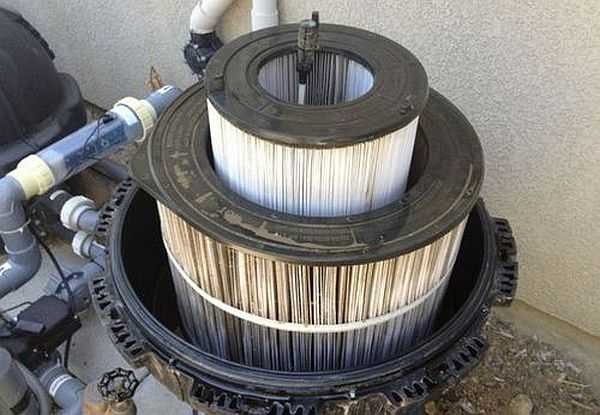
One of the types of cartridges for filtering water in a private house
In filling filters, bulk filtering material is poured into the container - sand, crushed shell, special filtrates (for example, BIRM (BIRM)). The simplest mechanical filter is a sand barrel with a washing function. One caveat: in the presence of a large amount of dissolved iron, it is still preferable to fill in a special filtrate, it is also a catalyst that oxidizes dissolved iron and manganese, causing them to precipitate.
Depending on the particle size of the backfill of such a filter, rather small particles can be retained. Sometimes they put two such filters in a row, only with different filling - first, the water enters the one where the filtrate is large, then with a smaller filling. Bulk filters for water purification from a well are good in that they require replacing the backfill approximately every three years. And in this they differ from the plate-like ones, the filter of which must be changed much more often: sometimes once a month, sometimes - once every three to six.
But for cleaning with the backfill filter to be effective, they need to periodically flush the filtrate. This usually happens by shutting off some taps and opening others. In this case, the water goes in the other direction, washing out the main amount of accumulated precipitation.
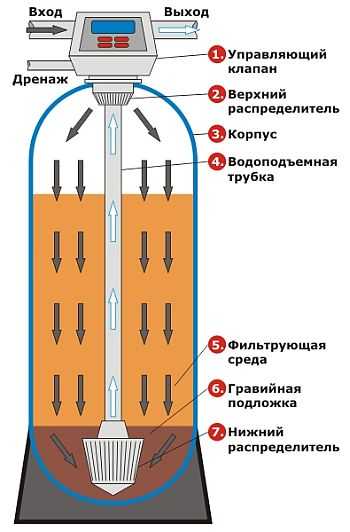
The principle of water purification in the filling filter
For an example of assembling two sequential filters for purifying water from coarse impurities, see the video.
You can read how to make a bailer for cleaning a well here.
How to remove iron from well water
The most common problem with raised water from wells is excessive iron content. If we talk about sanitary standards, then the permissible level of iron in water is 0.3 mg / l. If the concentration is increased, a specific taste appears. With an iron content of more than 1 mg / l, the color already changes - after a short settling, a characteristic reddish - rusty - shade appears.
There are no reliable data on the occurrence of pathology or the development of any diseases when drinking water with an increased amount of iron, but drinks and food do not have the most attractive appearance and taste. But this water can help with a low hemoglobin content in the blood, if you drink it long enough. Nevertheless, water is often purified from iron, and, at least, to sanitary standards. The reason is that iron is deposited on household appliances, which often becomes the reason for their failure. There are several types of equipment for removing iron from water.
Reverse osmosis
This is perhaps the most efficient way: almost all particles are removed. This water purification equipment contains special membranes that allow only H2O molecules to pass through. All the rest are deposited on the filter. A special cleaning system allows you to automatically remove accumulated contaminants that are discharged into the sewer or drain pit.
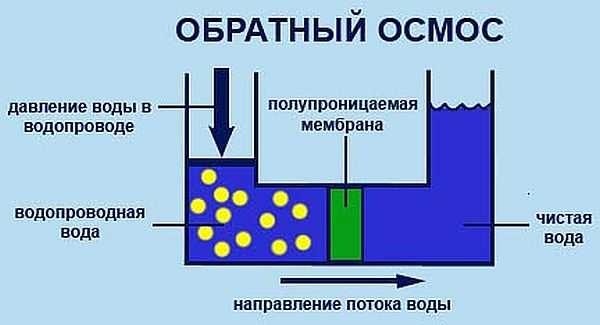
The principle of operation of the reverse osmosis system: a special membrane purifies water
Reverse osmosis removes not only iron, but also all other substances dissolved in water. Insoluble particles, including sand and ferric iron (rust), are a problem and clog filters.If you have a large amount of these impurities, coarse filters (described above) will be needed before reverse osmosis equipment. Another nuance: this equipment is installed on a water pipe and operates under a certain pressure.
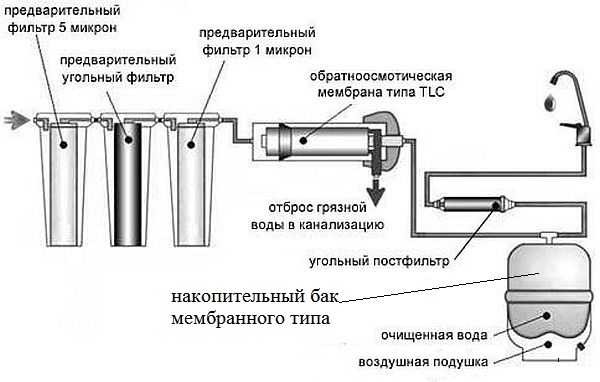
An example of a water purification system from a well with pre-filters and an osmosis system for the preparation of drinking water. A diaphragm tank is needed here to create constant pressure in the system.
And yet, the main disadvantage of such a system is its high cost, and the filters are also not cheap, and they need to be changed at about the same frequency as in cartridge installations (once every one to three months). Therefore, most often this equipment is installed for the preparation of drinking water - it is installed under the sink, a separate tap is taken out and used only for drinking or cooking. To purify the rest of the water - for technical needs - use other methods and methods.
Well water filters with ion-exchange resins
They are very similar in design to cartridge ones, but they contain special filters with resins, which replace iron with sodium. At the same time, water softening: magnesium and potassium ions are also bound. This equipment has several types of devices. For small volumes, cartridge filters are suitable, for large ones they are no longer enough and filter columns are installed, which can provide clean water at a significant flow rate. That is why, when selecting filters and equipment for water purification from a well, an average and peak flow rate is also required: in order to choose the right performance.
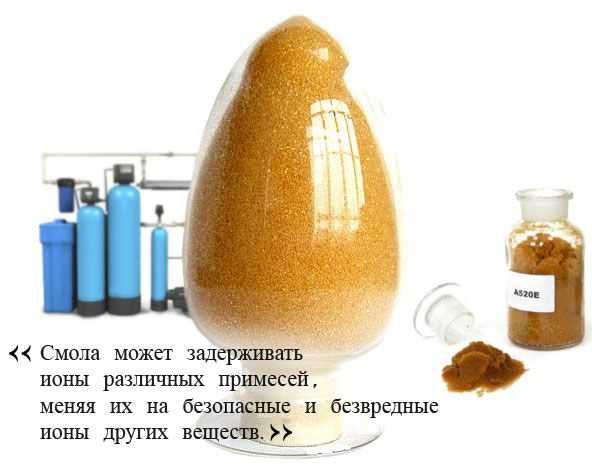
Ion exchange resins replace harmful substances with neutral
Removing iron from water by aeration
Well water filters are effective, but not cheap equipment. The solution to the problem is simpler: with aeration. The fact is that iron is present in water in two forms: a dissolved bivalent form and a trivalent precipitated form. The principle of aeration is based on the addition of oxygen to water, which oxidizes ferrous iron, dissolved in water to ferric, which precipitates as a rusty sediment. In addition to rust, this method neutralizes manganese, hydrogen sulfide (gives the smell of rotten eggs), ammonia.
Pressure aeration systems
By design, aerators can be divided into free-flow and pressure-operated. The pressure aerator consists of an aeration column and a compressor that pumps air. At the top of the column there is an automatic bleed valve that removes excess air. It can get water, so it is connected to the sewerage system.
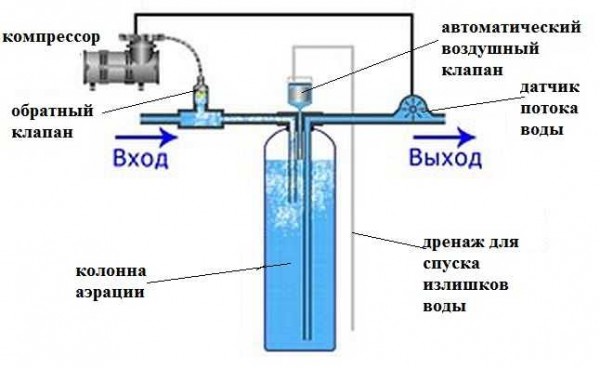
Method of water purification from iron using pressure aeration
Water is taken from the lower third of the aeration column, but not too low, since insoluble sediment accumulates at the bottom - the result of purification. The system turns on only when there is a water flow. For this, a flow sensor is installed at the outlet. As soon as the tap was opened, the compressor turned on, closed, it turned off.
A pressurized aeration system is also not the cheapest pleasure. But it is necessary if the content of iron or other solutes is exceeded 30 or more times. Otherwise, you cannot get rid of so much contamination: the filters will clog up very quickly.
Non-pressure systems for aeration water treatment
The second type of aeration system is gravity. It has a large container in which water settles. The volume of the container is from 600 liters, but in general it depends on the water consumption: no more than 50-60% of the available volume should be consumed so that the sediment remains at the bottom.
Water is supplied to the container directly from the well. The water level can be monitored by sensors - lower and upper levels or, as in the photo, a float switch of a borehole pump. To protect the system from overfilling, a water discharge pipe is made just above the critical level. He can go into the drainage or sewer system.It is important that there are some kind of visual sensors that there is too much water in the tank.
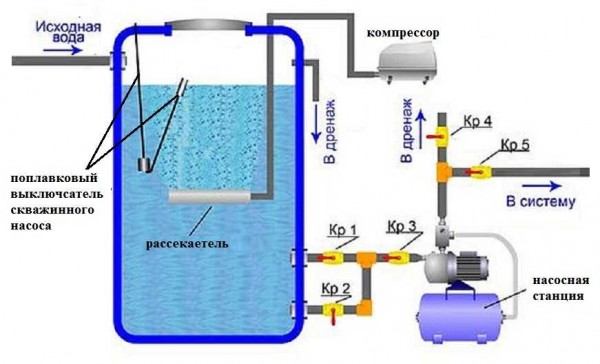
Gravity aeration system for purifying water from a well from iron, manganese, other impurities and dissolved gases
Such a system works as follows: Water is drawn into the tank to the required level, after which the pump is turned off. To purify the water, a compressor is turned on (it can be powerful for aquariums), which supplies air to the tank. It is distributed through a splitter, which is approximately halfway down.
To ensure constant pressure in the system, water from the tank can be pumped out using a pumping station. Water is withdrawn from the lower third, but not from the very bottom (through Tap 1): the purest water accumulates here. It enters the pumping station through Crane 3 and from there through a tee and Crane 5 goes into the system.
The scheme above also provides for a cleaning system. In this case, Crane 2 and Crane 5 are closed, Crane 2 and Crane 4 open, Sediments from the bottom with this position of the shut-off elements are discharged into the sewer or drainage system. After the sediments have been removed, you need to drain some more clean water in order to flush all the pipes well. Only when clean water flows into the sewer can all taps be returned to their original position.
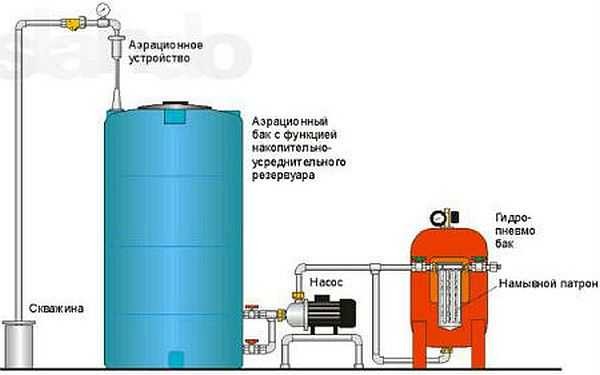
Another way to organize water purification from a well
ABOUTdrip irrigation systems can be read here.
Diy water purification systems from a well
One of the options for homemade water purification from a well using the aeration method is shown in the photo below. Two stages of aeration are used here for more complete water purification and removal of all impurities. The need for the second stage is determined based on the results of cleaning the first stage: the quality is far from always satisfactory. Re-aeration can help with this, but this is far from the only solution: you can install one of the filters. He will do a good job, and will rarely be hammered.
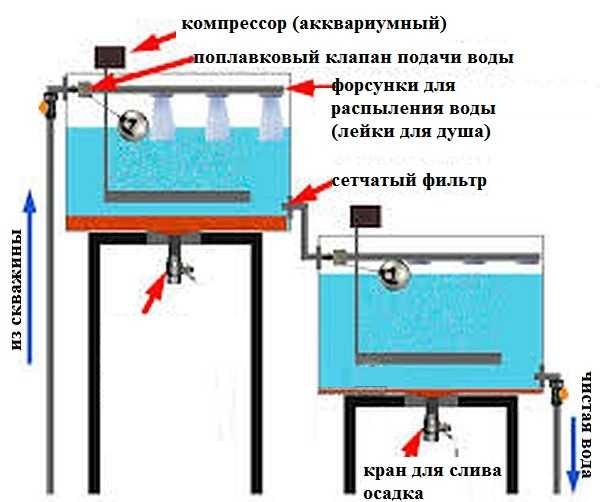
Two-stage well water purification system
In this embodiment, water from the well is supplied through the shower heads. Thus, primary oxygenation takes place. There is also a submerged atomizer from the aquarium compressor. The water level is controlled by a float switch (used to control the pool water). In the lower part of the tank there is a valve for draining the sediment.
From the first tank, water is taken out in the same way as in the previous version, from the lower third. the system is organized there similarly. From there, water can be supplied to the final cleaning and disinfection filter, and then diluted around the house.
For another example of a homemade water purification system from a well, see the video.
DIY tips for water treatment
If we talk about self-made systems, water purification from a well, then they often use different approaches and methods. Here are some quotes:
I remove iron cheaply and simply. I have a 120 liter tank. I pour 7-10 grams of lime into it, then blow it out with a compressor from the aquarium for 4-5 hours and let it stand for 3 hours. Then I supply water to a filter with a 2 micron cartridge, and from there to the system. This method was made in the country. I change the filter once a month. I made the system larger for a friend at home - by 500 liters. Two compressors work there for 12 hours. If you increase their power, the time can be reduced.
This is how the primary enrichment of water with oxygen in a home-made version looks like: a shower head through which water flows. Only raise it, preferably higher, so that more oxygen is captured
The second option is no less interesting:
I had a lot of sand and silt coming out of the well: my flow rate is high and "pulls" a lot of all sorts of rubbish. I solved the problem by installing a filter. He only gutted his own cassette (after the filter became unusable), and poured crushed shells into it. Some of them use marble chips. Works fine too. Only the fraction is needed not small, otherwise it will be quickly clogged.And then I have a tank with blowing (aeration), and after it there is a filter that removes what the first two could not. The last filter I have is a barrel filled with BIRM. It has a flush valve. So once every couple of weeks I wash the backfill, but it needs to be changed after three years.

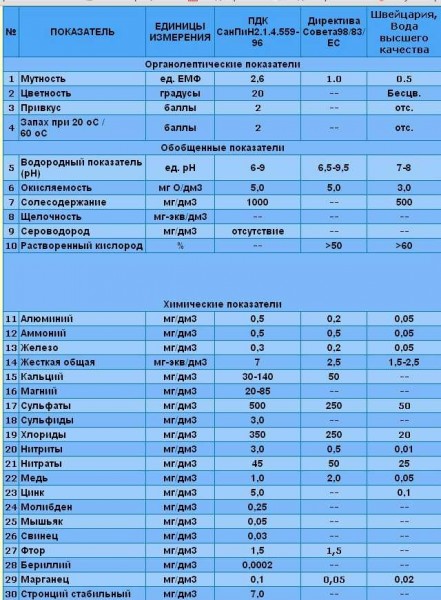
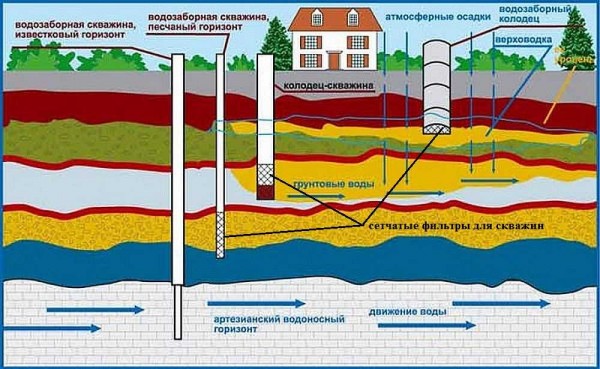
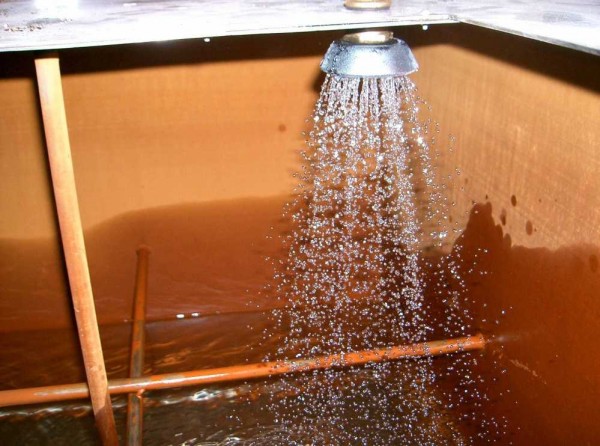
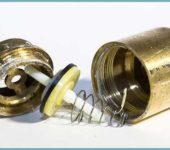
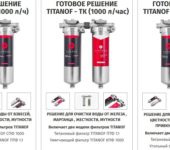

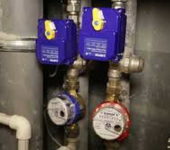
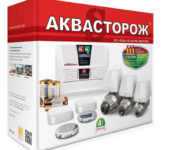





At our dacha, the water from the well seems to be transparent, but the taste of iron is present, I don't even know if it can be used at all or not.
It is best to take the water for analysis. Then it will be clear for sure. In general, you can ask the neighbors. You most likely have one aquifer and if they drink water, then you can. But how tasty it is without cleaning is another matter.
The water from the well immediately goes clear, but after standing it rusts. I don't think you need to drink such water. And how to drink it and prepare food.
Sergey, I'm certainly not an expert in this, but in one of the videos, this was mentioned. You have two acid iron in your water. As far as I understand nedooctsoennoe. It is under-oxidized due to the fact that there is no oxygen under the ground. But as soon as it hits the surface and is enriched with oxygen, it finally oxidizes and falls out in the form of rust.
In general, you need a filter based on some kind of resin. The resin will oxidize the iron and it will precipitate in the filter itself. Salt is still used there to clean the resin from embedded iron. It is thanks to her that iron precipitates.
It is possible to purify the water, but I won't tell you about the money and manufacturers.
submit your email address to send the TOR and water analysis
The site is informational, we do not sell anything, we do not provide services.